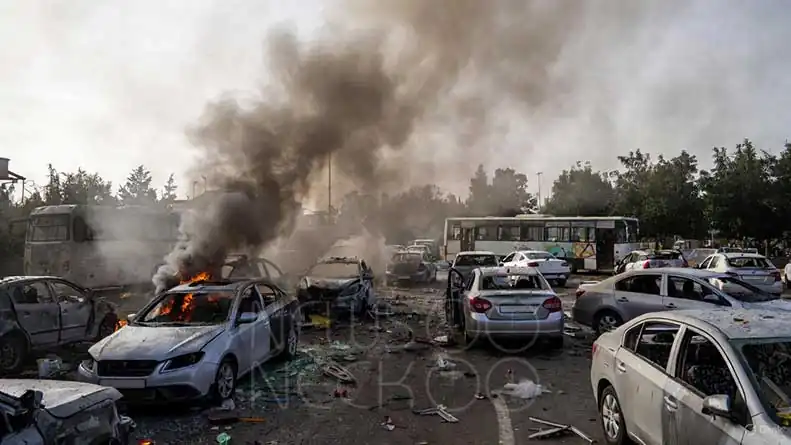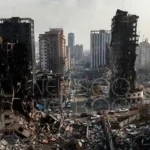A year after a ceasefire ended the Israel-Hezbollah war, a drone strike on a refugee camp has killed more than a dozen people. The two sides can’t even agree on what was hit.
The car was parked outside a mosque in Ein el-Hilweh, one of Lebanon’s largest and most densely packed Palestinian refugee camps. It was a Tuesday, an ordinary day in a place where ordinary days are hard to come by.
Then, around midday, a drone appeared overhead. Seconds later, the car exploded.
When the smoke cleared, thirteen people were dead. Several others lay wounded. Ambulances raced through the narrow streets of the camp, sirens wailing, trying to reach the injured before it was too late.
It was the deadliest airstrike Lebanon had seen in a year—since the ceasefire that was supposed to end the fighting between Israel and Hezbollah. That fragile peace, which many residents had barely dared to trust, suddenly felt more fragile than ever.
A Camp Built on Broken Promises
To understand what happened on Tuesday, you need to understand Ein el-Hilweh.
The camp sits on the outskirts of Sidon, a coastal city in southern Lebanon. It was established in 1948, when hundreds of thousands of Palestinians fled or were forced from their homes during the creation of Israel. They were told their displacement would be temporary. Seventy-seven years later, their grandchildren and great-grandchildren are still living there.
“Refugee camp” sounds temporary, like rows of tents that might be packed up someday. But Ein el-Hilweh is a city now, home to more than 70,000 people. Concrete buildings rise several stories high. Narrow alleyways wind between apartments. Children play in cramped courtyards. Families have spent entire lifetimes here, waiting for a return that may never come.
It’s also a place where armed groups operate. Lebanese security forces have limited authority inside the camp. Various Palestinian factions—some militant, some political, some both—maintain a presence. Hamas, the group that controls Gaza and fought a war with Israel last year, has members here.
The camp exists in a kind of legal and political limbo. Palestinians in Lebanon face significant restrictions on employment and property ownership. They can’t vote. They can’t easily leave. For many, especially the young, the future looks like an endless repetition of the present: trapped between countries that don’t want them and a homeland they can’t return to.
Two Stories, Both Claiming Truth
After Tuesday’s strike, two very different versions of what happened emerged almost immediately.
The Israeli military said it had targeted a Hamas training compound. According to their account, the compound was being used to prepare an attack against Israel. The strike was precise, intentional, and justified. They added that the Israeli army would continue to act against Hamas wherever the group operates, including in Lebanon.
Hamas told a completely different story. In their statement, they condemned the attack and said it hit a sports playground—a place where people, possibly children, gather to play football or basketball. They denied operating any training compound in that location.
Thirteen people are dead. That much is certain. The Lebanese Health Ministry confirmed it. The state-run National News Agency reported it. But what those thirteen people were doing when they died, and whether they were combatants or civilians, depends entirely on who you ask.
This is the fog of war, where truth becomes the first casualty and everyone claims righteousness.
The Journalists Who Couldn’t Get Through
Here’s something that should trouble everyone: after the strike, journalists tried to reach the scene. They wanted to see what had been hit, to document the damage, to speak with witnesses, to verify the competing claims.
Hamas fighters in the area stopped them.
Ambulances were allowed through. The wounded and the dead were evacuated. But the reporters—the people whose job is to tell the rest of the world what actually happened—were kept away.
Maybe Hamas had security concerns. Maybe they were worried about Israeli surveillance. Maybe they simply didn’t want cameras documenting whatever was at that site.
But when journalists can’t access the scene of an airstrike that killed thirteen people, it becomes nearly impossible to know the full truth. All we’re left with are official statements from parties with obvious reasons to shape the narrative in their favor.
A Pattern That Keeps Repeating
Tuesday’s strike wasn’t an isolated incident. It was the latest chapter in a story that’s been unfolding across Lebanon for the past two years.
Israeli airstrikes have killed scores of officials from Hezbollah, the powerful Lebanese militant group and political party. They’ve also targeted members of Palestinian factions like Hamas. Sometimes these strikes happen in southern Lebanon, near the Israeli border. Sometimes they happen in Beirut, the capital. And sometimes, like Tuesday, they happen in refugee camps.
Israel says these strikes are necessary to protect its security, to prevent attacks before they happen, to eliminate threats wherever they emerge. They point to rockets fired from Lebanon, to tunnels dug under the border, to weapons smuggled and militants trained.
Lebanon’s government, weak and fractured after years of economic crisis and political dysfunction, protests but can do little. The international community issues statements expressing concern. And the strikes continue.
For the people living in places like Ein el-Hilweh, this means existing in a constant state of uncertainty. Any car could be a target. Any building could be hit. Any ordinary day could end in sirens and smoke.
The Ceasefire That Wasn’t
A year ago, Israel and Hezbollah reached a ceasefire after months of fighting. The agreement was supposed to bring stability to Lebanon’s south. For a while, it mostly held. The daily exchanges of fire across the border stopped. People began to hope that maybe, just maybe, they could rebuild their lives.
Tuesday’s airstrike was the deadliest since that ceasefire took effect. It’s a reminder that peace in this region is always conditional, always fragile, always one drone strike away from unraveling.
The ceasefire was between Israel and Hezbollah. But Hamas operates separately. The war in Gaza continues. And as long as that conflict rages, Lebanon—caught between regional rivalries it can barely control—remains vulnerable to spillover violence.
The Thirteen
We don’t know much about the thirteen people who died on Tuesday. Their names haven’t been widely reported. Their stories remain largely untold.
Were they militants preparing an attack, as Israel claims? Were they civilians on a playground, as Hamas insists? Were they something in between—young men drawn into armed groups because they saw no other future in a camp that offered them none?
Their families know. Their friends know. The community in Ein el-Hilweh knows. But for the rest of the world, they’re just a number: thirteen dead in another Middle East airstrike, another tragic headline in a region where tragic headlines have become routine.
That’s perhaps the saddest part of all. Not just the deaths, but how quickly we’ve become numb to them. Another airstrike, another body count, another day in a conflict that seems to have no end.
For the people in Ein el-Hilweh—still living in a camp built for their grandparents’ generation, still waiting for a future that never arrives—Tuesday was a reminder that even when the wars officially end, the violence doesn’t.
The ambulances have left. The dead have been buried. Life in the camp continues, as it always does, in the shadow of drones that could strike at any moment.
And somewhere, perhaps in a military command center or a militant hideout, someone is already planning the next move in a conflict that just keeps repeating itself.
Based on reports from Sidon, Lebanon, November 19, 2025.













